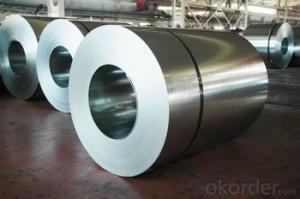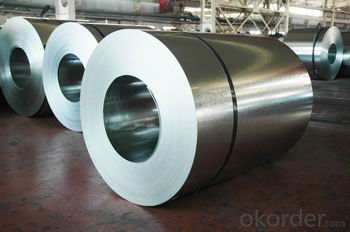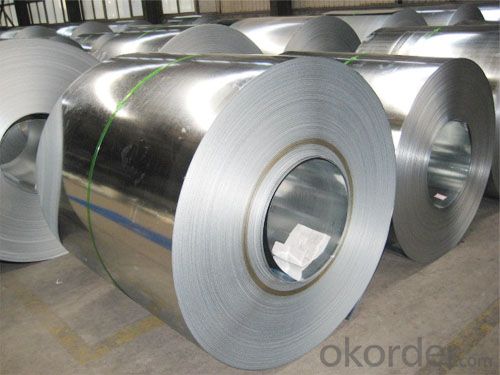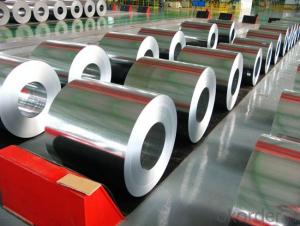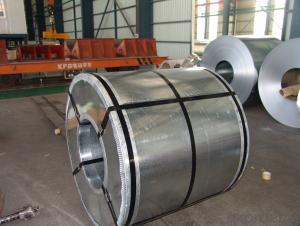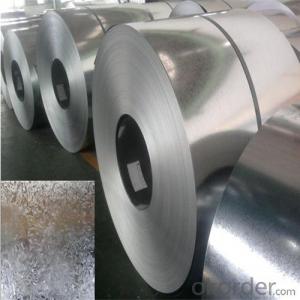THE BEST HOT-DIP GALVANIZED STEEL COILS
- Loading Port:
- China Main Port
- Payment Terms:
- TT OR LC
- Min Order Qty:
- -
- Supply Capability:
- -
OKorder Service Pledge
OKorder Financial Service
You Might Also Like
Quick Details |
|
|
|
|
|
Standard: | AISI,ASTM,BS,DIN,GB,JIS | Grade: | SGCC,DX51D/DX52D/S250,280GD | Thickness: | 0.12-4.0 mm |
Place of Origin: | Brand Name: | N/M | Model Number: | ssp-226 | |
Type: | Steel Coil | Technique: | Cold Rolled | Surface Treatment: | galvanized/ Galvalume/zinc coatting |
Application: | strong anti-corrosion ability,cold bending molded manufacturablity | Special Use: | High-strength Steel Plate | Width: | 600-1250 mm |
Length: | in coil | product: | g40 prime/secordary hot-dip galvanized cold rolled steel coil/sheet |
|
|
Packaging & Delivery |
|
|
|
|
|
Packaging Detail: | standard export package,Other types of packing can be customized as per client's requirement. | ||||
Delivery Detail: | as per client's requirements | ||||
Specifications
1.Mateials:SGCC,DX51D / DX52D /S250,280GD
2.Size:width:600-1250mm(900mm,1215mm,1250mm,1000mm the most common)
thickness:0.15-2.0mm
length:1000-6000mm,as your require
3.Zinc coating :60-180g( as required)
4.Coil id:508mm
5.Coil weight: 3-5MT(as required)
6. Surface:regular/mini/zero spangle, chromated, skin pass, dry etc.
7. Application:
With excellent cold bending molded manufacturablity, good decoration effect, strong anti-corrosion ability, galvanized steel coils and sheets are also pollution-free and easily recycled. Accordingly, they can be used as final products and basic plates of color coated steel coils.
8.PackagingDetails:
Standardexport package.
Othertypes of packing can be customized as per client's requirements.
- Q: How are steel coils transported and stored?
- Steel coils are typically transported using specialized trailers or railcars, ensuring secure and stable transportation. They are usually stored in warehouses or outdoor yards, stacked in neat rows using specialized equipment like coil racks or cradles. These storage methods help maximize space efficiency and prevent damage to the coils.
- Q: How are steel coils used in the production of railway tracks?
- Railway tracks rely heavily on steel coils, which are indispensable in their production. These coils, typically made from top-notch steel, are utilized to create the rails that constitute the bedrock of the tracks. The process commences with the unwinding of the steel coils, which are then fed into a sequence of machines that mold and fashion them into the desired rail profile. Initially, the steel coils are passed through a rolling mill, where they undergo gradual flattening and shaping, thereby transforming into elongated steel strips. This technique, known as hot rolling, involves heating the steel to high temperatures to enhance its pliability. The rolling mill exerts substantial pressure on the steel, progressively molding it into the desired rail shape. Once the steel coils have been rolled into the requisite form, they are subsequently severed into individual rail lengths. The length of these rails may vary depending on the specifications of the railway track being produced. The rail lengths then undergo further processing to eliminate any flaws and straighten them out. Following this initial shaping and processing, the rails undergo a series of supplementary treatments. These treatments may entail heat treatment to bolster their strength and durability, as well as various surface treatments to prevent corrosion and wear. Once the rails have undergone all the necessary treatments, they are ready for installation on the railway track. They are laid out meticulously in a predetermined pattern, with each rail securely fastened to the sleepers or ties. The continuous length of steel provided by the coils ensures a seamless and uniform track, enabling trains to travel smoothly and safely. In conclusion, steel coils are crucial components in the production of railway tracks. They are utilized to manufacture the rails that serve as the foundation of the tracks, guaranteeing durability, strength, and a smooth surface for trains to traverse. The use of high-quality steel coils in this process is essential to ensure the safety and efficiency of railway transportation.
- Q: Hi All,I was wanting to know,on the quality bikes such as Trek,Giant etc is the aluminum frames as strong as the steel frame bikes? I have heard conflicting reports on this,so thought I would ask here for more input.Thanks!
- Someone stated even the $99 walmart bikes are aluminum now. WRONG! Most Walmart bikes have steel frames unless you drop about $200.00. Personally, I prefer aluminum over steel. It's lighter, most times - just as strong and won't rust if you get a ding or scrape in the paint. See links below on Trek M/B. Trek 820 - steel frame - $329.99. Trek 3500 - aluminum frame - $359.99.
- Q: What is the difference between cold rolled strip and cold rolled steel coil?
- Cold rolled steel strip: the width is below 900mm! Cold rolled steel coil: the width is above 1000mm! Materials and purposes are not very different, basically the same!
- Q: Maybe it is obvious. But i have thought alot about it.I thought steel at a cool temperature was unbreakable. I am not one for science or physics or engineering (i am a political science major). But i don't understand why the planes that struck the world trade center on 9-11 didn't just dent the side and fall,How did the place break the steel? Was it the velocity? Is steel easily broken?I realized that i wasn't taught how the planes broke the steel, and that no one ever asked. I searched the web and i couldn't find the answer or even anyone who had asked the question before.(i don't care about conspiracy theories, i just want scientific facts)
- I saw a one-hour program about this on PBS a couple of years ago. The buildings were constructed with the concrete-clad steel supporting columns at the center of the buildings, with a relatively thin lattice of steel struts along the outer wall. When the planes hit, they sheered through the thin steel struts easily by sheer momentum, while, at the same time, the thin steel stripped off the wings. The bodies of the planes got as far as the supporting columns in the center of the buildings, but were stopped there. The heaviest, densest pieces, the engines, went completely through the buildings and popped out the other side. It's important to understand that even light materials can cut through metal, if the light material is going fast enough. I saw this first hand, when I was in the Navy and stationed on board ship. We had a helicopter crash on our flight deck during heavy weather. The blades were made of light, carbon-composite material, but they were going so fast that they cut through the aluminum deck. I still have photos of that damage.
- Q: How many millimeters is a number 3 steel crochet hook?
- A okorder /. . If your hooks are marked by letters and milimeters, they are likely intended for working with YARN, not crochet thread. The steel hooks are smaller and are used with thread rather than with yarn. In addition, if you're working with a vintage pattern, a hook may be called for that you cannot purchase today. Here is a web site that explains many of the puzzling questions about hooks
- Q: who, when and where was dual phase steel invented?
- Dual Phase steels refers to a distinct group of alloys which are used for automotive bodies. These were developed to give improved deep drawing (for shaping) and strength while on the road. Most of the work was started at the same time in the 1970s as a response to the oil crisis (history repeats!) with SSAB in Europe, US Steel and British Steel leading the way. There are many variants of the dual phase alloys prefered by each of the auto manufacturers. The work on these steels led the way for TRIP (transformation induced plasticity) steels, rephosphorised steels and HSLA (high strength low alloy) steels. There is a distinction between these steels and duplex steels which typically refer to austenitic/ferrtic stainless steels. Also be aware that everyday low carbon steels with 0.1%-0.6% carbon will have a ferritic/pearlitic structure but are not considered to be dual phase So to summarise: Who - major steel companies worldwide When - from about 1973 onwards (up to around 1977 when the developments went in other directions) Where - Europe, USA and Japan (but I'm not sure who it was in Japan doing the work)
- Q: How do steel coils contribute to the automotive aftermarket?
- Steel coils contribute to the automotive aftermarket by serving as a crucial raw material for manufacturing various components used in vehicles. These coils are responsible for providing strength, durability, and structural integrity to parts like body panels, chassis components, suspension systems, and exhaust systems. Additionally, steel coils are also used in the production of aftermarket accessories such as bumpers, grilles, and custom body kits. Their availability and versatility make steel coils an essential resource for the automotive industry, enabling the production of high-quality aftermarket products that enhance the performance and aesthetics of vehicles.
- Q: The Iron and Steel Corporation of Great Britain (1949) or Iron and Steel Bill was introduced in 1949 during the Labour post-war Government.What was it introduced for?
- To nationalise the companies, which means the government owned them from that point on. Previously the manufacturers were various private companies which had shareholders, the government bought out the shareholders and therefore owned the companies and this is the final stage in nationalisation.
- Q: What are chemical properties of high speed steel? Physical properties?What is high speed steel used for? One interesting fact about high speed steel?
- wikipedia: High speed steel (often abbreviated HSS, sometimes HS) is a material usually used in the manufacture of machine tool bits and other cutters. It is often used in power saw blades and drill bits. It is superior to the older high carbon steel tools used extensively through the 1940s in that it can withstand higher temperatures without losing its temper (hardness). This property allows HSS to cut faster than high carbon steel, hence the name high speed steel. At room temperature, in their generally recommended heat treatment, HSS grades generally display high hardness (above HRC60) and a high abrasion resistance (generally linked to tungsten content often used in HSS) compared to common carbon and tool steels. see reference for more info .
Send your message to us
THE BEST HOT-DIP GALVANIZED STEEL COILS
- Loading Port:
- China Main Port
- Payment Terms:
- TT OR LC
- Min Order Qty:
- -
- Supply Capability:
- -
OKorder Service Pledge
OKorder Financial Service
Similar products
Hot products
Hot Searches
Related keywords
